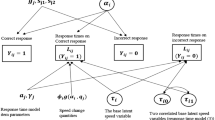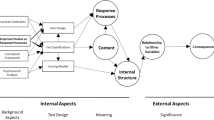Abstract
Random guessing behaviors are frequently observed in low-stakes assessments, often attributed to factors such as test-takers lacking motivation or experiencing time constraints and fatigue. Existing research suggests that responses stemming from random guessing behaviors introduce biases into the constructs and relationships of interest. This is particularly problematic when estimating the relationship between speed and ability. This study introduces a Mixture Fluency model designed to account for random guessing behaviors while utilizing valid response accuracy and response time to uncover students' latent attribute profiles. The model directly addresses a limitation present in the Fluency cognitive diagnostic model (Wang & Chen, Psychometrika, 85, 600–629, (2020), which assumes that test-takers consistently employ solution behaviors when answering questions. To investigate the effectiveness of the proposed Mixture Fluency model, we conducted a simulation study encompassing various simulation conditions. Results from this study not only confirm the model's ability to detect potential random guessing behaviors but also demonstrate its capacity to enhance the inference of targeted latent constructs within the assessment. Additionally, we showcase the practical utility of the proposed model through an application to real data.





Similar content being viewed by others
Data Availability
The real data in this study is avaliable through the hmcdm R package https://cran.r-project.org/web/packages/hmcdm/index.html.
References
Bolt, D. M., Cohen, A. S., & Wollack, J. A. (2002). Item parameter estimation under conditions of test speededness: Application of a mixture Rasch model with ordinal constraints. Journal of Educational Measurement, 39(4), 331–348.
Cai, Y., & Tu, D. (2015). Extension of cognitive diagnosis models based on the polytomous attributes framework and their Q-matrices designs. Acta Psychologica Sinica, 47(10), 1300.
Chen, J., & de la Torre, J. (2013). A general cognitive diagnosis model for expert-defined polytomous attributes. Applied Psychological Measurement, 37(6), 419–437.
Cheng, Y., & Shao, C. (2022). Application of change point analysis of response time data to detect test speededness. Educational and Psychological Measurement, 82(5), 1031–1062.
Cui, Y., & Li, J. (2015). Evaluating person fit for cognitive diagnostic assessment. Applied Psychological Measurement, 39(3), 223–238.
Cui, Y., & Mousavi, A. (2015). Explore the usefulness of person-fit analysis on large-scale assessment. International Journal of Testing, 15(1), 23–49.
De La Torre, J. (2011). The generalized DINA model framework. Psychometrika, 76, 179–199.
Deribo, T., Goldhammer, F., & Kroehne, U. (2023). Changes in the speed–ability relation through different treatments of rapid guessing. Educational and Psychological Measurement, 83(3), 473–494.
Fang, G., Liu, J., & Ying, Z. (2019). On the identifiability of diagnostic classification models. Psychometrika, 84, 19–40.
Gelman, A., & Rubin, D. B. (1992). Inference from iterative simulation using multiple sequences. Statistical Science, 7(4), 457–472.
Gelman, A., Carlin, J. B., Stern, H. S., Dunson, D. B., Vehtari, A., & Rubin, D. B. (2013). Bayesian data analysis. CRC Press.
Gierl, M. J., Cui, Y., & Zhou, J. (2009). Reliability and attribute-based scoring in cognitive diagnostic assessment. Journal of Educational Measurement, 46(3), 293–313.
Haertel, E. H. (1989). Using restricted latent class models to map the skill structure of achievement items. Journal of Educational Measurement, 26(4), 301–321.
Henson, R. A., Templin, J. L., & Willse, J. T. (2009). Defining a family of cognitive diagnosis models using log-linear models with latent variables. Psychometrika, 74, 191–210.
Hsu, C. L., Jin, K. Y., & Chiu, M. M. (2020). Cognitive diagnostic models for random guessing behaviors. Frontiers in Psychology, 11, 570365.
Junker, B. W., & Sijtsma, K. (2001). Cognitive assessment models with few assumptions, and connections with nonparametric item response theory. Applied Psychological Measurement, 25(3), 258–272.
Levy, R., & Mislevy, R. J. (2017). Bayesian psychometric modeling. CRC Press.
Lu, J., Wang, C., Zhang, J., & Tao, J. (2020). A mixture model for responses and response times with a higher-order ability structure to detect rapid guessing behaviour. British Journal of Mathematical and Statistical Psychology, 73(2), 261–288.
Lu, J., Wang, C., Zhang, J., & Wang, X. (2024). A sequential Bayesian changepoint detection procedure for aberrant behaviours in computerized testing. British Journal of Mathematical and Statistical Psychology, 77(1), 31–54.
Ma, W. (2022). A higher-order cognitive diagnosis model with ordinal attributes for dichotomous response data. Multivariate Behavioral Research, 57(2–3), 408–421.
Man, K., Harring, J. R., Ouyang, Y., & Thomas, S. L. (2018). Response time-based nonparametric Kullback-Leibler divergence measure for detecting aberrant test-taking behavior. International Journal of Testing, 18(2), 155–177.
Qiao, X., & Jiao, H. (2021). Explanatory cognitive diagnostic modeling incorporating response times. Journal of Educational Measurement, 58(4), 564–585.
Ravand, H. (2016). Application of a cognitive diagnostic model to a high-stakes reading comprehension test. Journal of Psychoeducational Assessment, 34(8), 782–799.
Shao, C., Li, J., & Cheng, Y. (2016). Detection of test speededness using change-point analysis. Psychometrika, 81, 1118–1141.
Spiegelhalter, D. J., Best, N. G., Carlin, B. P., & Van Der Linde, A. (2002). Bayesian measures of model complexity and fit. Journal of the Royal Statistical Society Series B: Statistical Methodology, 64(4), 583–639.
Templin, J. L., & Henson, R. A. (2006). Measurement of psychological disorders using cognitive diagnosis models. Psychological Methods, 11(3), 287.
van der Linden, W. J. (2006). A lognormal model for response times on test items. Journal of Educational and Behavioral Statistics, 31(2), 181–204.
van der Linden, W. J., & Lewis, C. (2015). Bayesian checks on cheating on tests. Psychometrika, 80(3), 689–706.
Van der Linden, W. J., & Guo, F. (2008). Bayesian procedures for identifying aberrant response-time patterns in adaptive testing. Psychometrika, 73(3), 365–384.
Wang, S., & Chen, Y. (2020). Using response times and response accuracy to measure fluency within cognitive diagnosis models. Psychometrika, 85(3), 600–629.
Wang, C., & Xu, G. (2015). A mixture hierarchical model for response times and response accuracy. British Journal of Mathematical and Statistical Psychology, 68(3), 456–477.
Wang, C., Xu, G., & Shang, Z. (2018). A two-stage approach to differentiating normal and aberrant behavior in computer-based testing. Psychometrika, 83, 223–254.
Wang, S., Zhang, S., & Shen, Y. (2020). A joint modeling framework of responses and response times to assess learning outcomes. Multivariate Behavioral Research, 55(1), 49–68.
Wise, S. L., & DeMars, C. E. (2005). Low examinee effort in low-stakes assessment: Problems and potential solutions. Educational Assessment, 10(1), 1–17.
Wise, S. L., & Kong, X. (2005). Response time effort: A new measure of examinee motivation in computer-based tests. Applied Measurement in Education, 18(2), 163–183.
Wu, H. M. (2019). Online individualised tutor for improving mathematics learning: A cognitive diagnostic model approach. Educational Psychology, 39(10), 1218–1232.
Zhan, P., Bian, Y., & Wang, L. (2016). Factors affecting the classification accuracy of reparametrized diagnostic classification models for expert-defined polytomous attributes. Acta Psychologica Sinica, 48(3), 318.
Zhan, P., Jiao, H., & Liao, D. (2018). Cognitive diagnosis modelling incorporating item response times. British Journal of Mathematical and Statistical Psychology, 71(2), 262–286.
Zhan, P., Wang, W. C., & Li, X. (2020). A partial mastery, higher-order latent structural model for polytomous attributes in cognitive diagnostic assessments. Journal of Classification, 37, 328–351.
Zhan, P., Chen, Q., Wang, S., & Zhang, X. (2023). Longitudinal joint modeling for assessing parallel interactive development of latent ability and processing speed using responses and response times. Behavior Research Methods. https://doi.org/10.3758/s13428-023-02113-5
Zhang, S., & Wang, S. (2018). Modeling learner heterogeneity: A mixture learning model with responses and response times. Frontiers in Psychology, 9, 2339.
Acknowledgements
This study is partially supported by 2019 National Academy of Education and Spencer Postdoctoral Fellowship Program.
Author information
Authors and Affiliations
Corresponding author
Ethics declarations
Conflict of interest
The author(s) declared no potential conflicts of interest with respect to the research, authorship, and/or publication of this article.
Additional information
Publisher's Note
Springer Nature remains neutral with regard to jurisdictional claims in published maps and institutional affiliations.
Open Practices Statement
The cpp code to execute the proposed Mixture Fluency model, the real data set, the simulation code and real data analysis code can be downloaded from https://anonymous.4open.science/r/BMR-code-5D27/.
Appendix
Appendix
Priors and posteriors of parameters.
Gibbs algorithm
The Gibbs sampling method was used to sample model parameters based on the posterior distributions as listed above. The specific update procedures are listed as follows.

Supplement to simulation results when attribute profiles were generated from the discrete uniform distribution and \({\phi }_{i}\sim \left({\mathrm{1,0.6}}^{2}\right){1}_{\left\{{\phi }_{i}>1\right)}\)
Supplement to simulation results when attribute profiles were generated from the discrete uniform distribution and \({\phi }_{i}\sim N\left({\mathrm{0.6,0.3}}^{2}\right){1}_{\left\{{\phi }_{i}>0.4\right)}\)
Simulation results when attribute profiles were generated from truncated normal distribution
Rights and permissions
Springer Nature or its licensor (e.g. a society or other partner) holds exclusive rights to this article under a publishing agreement with the author(s) or other rightsholder(s); author self-archiving of the accepted manuscript version of this article is solely governed by the terms of such publishing agreement and applicable law.
About this article
Cite this article
Liu, Z., Wang, S., Zhang, S. et al. A Mixture Fluency model using responses and response times with cognitive diagnosis model framework. Behav Res (2024). https://doi.org/10.3758/s13428-024-02338-y
Accepted:
Published:
DOI: https://doi.org/10.3758/s13428-024-02338-y





